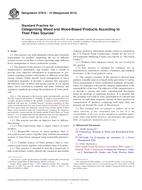1.1 This practice covers the qualification of a squeeze process consisting of a combination of a squeeze tool, pipe, and squeeze-off procedures to avoid long-term damage in polyethylene gas pipe. This practice examines the inside and outside surfaces of the pipe near the squeeze to determine the existence of features indicative of long-term cracking. The occurrence of these features depends on the squeeze tool design, the pipe being squeezed, and the squeeze procedures being used. This practice is particularly appropriate for pre-1975 Polyethylene (PE) pipe, and for pipe with diameter greater than or equal to 8 in., because of the greater possibility of long term damage.
1.2 After the visual screening identifies a viable squeeze process, a sustained pressure test in accordance with Specification D 2513 should be used to conform the viability.
1.3 This practice is for use by squeeze-tool manufacturers and gas utilities for all squeeze tools made in accordance with Specification F 1563; pipe manufactured in accordance with Specification D 1513, up to and including pipe diameters of 12 in.; and squeeze procedures in accordance with Guide F 1041.
1.4 Governing codes and project specifications should be consulted. Nothing in this practice should be construed as recommending practices or systems at variance with governing codes and project specifications.
1.5 Where applicable in this Guide, “pipe” shall mean “pipe and tubing.”
1.6 The values stated in inch-pound units are to be regarded as standard. The values in parentheses are for information only.
1.7 This standard does not purport to address all of the safety concerns, if any, associated with its use. It is the responsibility of the user of this standard to establish appropriate safety and health practices and determine the applicability of regulatory limitations prior to use.
Product Details
- Published:
- 01/01/1996
- Number of Pages:
- 3
- File Size:
- 1 file , 66 KB


